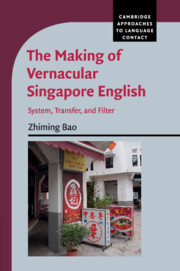Singapore English is a contact language with a constant linguistic substratum and superstratum. It lends itself to an interesting case study on how linguistic neologisms emerge out of a pool of competing features from the typologically distinct languages active in the contact ecology. This paper investigates the aspectual system of Singapore English and that of Chinese, the main substrate language, and of English, the lexical-source language. Despite the presence of competing aspectual categories from the two languages, the aspectual system of Singapore English is essentially the Chinese system filtered through the morphosyntax of English. Substrate influence is systemic, and the competing grammatical subsystems do not mix.
